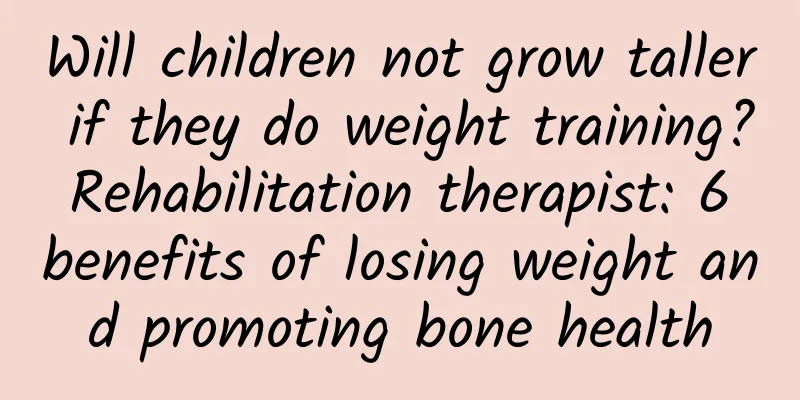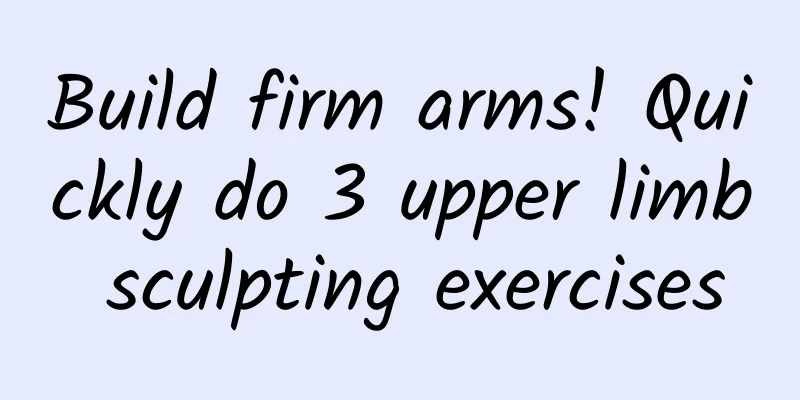Will children not grow taller if they do weight training? Rehabilitation therapist: 6 benefits of losing weight and promoting bone health

|
Fitness is becoming more and more popular. Adults do weight training not only to lose weight, but also to build muscle and reduce fat. However, can growing children and adolescents engage in weight training? Will applying too much pressure on the bones affect the development of the growth plates, leading to short growth? Rehabilitation specialists will share 6 major benefits of weight training for children, including helping them lose weight and promoting bone health, as well as safety tips for weight training and 3 weight training methods suitable for children. Can children do weight training? Before discussing whether growing children can do weight training, we need to talk about what "weight training" is? Rehabilitation specialist Chen Yuren said that when many people think of weight training, they think of heavy weight training such as weightlifting, barbells, bench presses, etc., but in fact, weight training, or "muscle strength training", refers to all training that applies force to muscles and allows the muscles to actively contract and resist them, including weightlifting in the Olympics, mechanical equipment in the gym, as well as dumbbells, kettlebells and resistance training using elastic bands. Because children's growth plates are more fragile than mature bones, the thinking in the 1980s was that the stress on bones from weight training and muscle contractions might impede growth without providing additional benefits. However, more and more medical research tells us that as long as appropriate weight training is designed according to the child’s age and tolerance, not only is the risk of sports injuries very low, it will also not have a negative impact on the child’s growth and development. Experts believe that children can safely engage in professionally assessed and adjusted weight training starting from the age of 7-8, and that weight training not only has no harm, but also brings additional benefits to children. What parents often want to know is whether weightlifting will affect the development of the spine or even prevent their children from growing taller? Rehabilitation specialist Chen Yuren said that the common conclusion of many studies is that weightlifting as a part of children's weight training not only does not affect development, but can also improve body composition and enhance cardiopulmonary endurance. As long as common dumbbells and kettlebells are used moderately, children can also get the benefits of weight training without affecting their development. It is worth mentioning that the intensity of weight training for children should be carefully controlled. If the maximum weight a child can do is RM, the training weight is recommended to be between 60% and 80% of RM, which can reduce the chance of injury. (Photo provided by rehabilitation specialist Chen Yuren) [6 benefits of weight training for children] We now know that as long as children engage in appropriate weight training, it will not only not affect their growth and development, but also has the following benefits: • Reduce the risk of developing cardiopulmonary disease in adulthood: A large-scale medical study 20 years ago has told us that establishing exercise habits in children at an early age can reduce the chances of them getting cardiovascular disease when they grow up. Adding weight training to children's exercise menu can make exercise more diverse, rich and interesting, and children are less likely to get bored with a single type of exercise. • Reduce obesity: Many medical studies have found that weight training can change the metabolism and body composition of obese children and adolescents and reduce the proportion of body fat. The most important thing is that it can "increase insulin sensitivity", which in plain language means that it allows the body to metabolize blood sugar more efficiently and prevents excessive blood sugar from accumulating into fat. • Promotes bone health: Intuitively, we worry that the stress of weight training will damage bones, but in fact, bones are a living organ that is constantly metabolizing. Moderate weight training can actually help bones grow, increase bone strength, and reduce the risk of osteoporosis in adulthood. In addition, weight training can increase muscle strength, and stronger muscle strength can increase stimulation to bones and help bones grow. (Photo provided by rehabilitation specialist Chen Yuren) • Improve sports performance: Studies have shown that weight training can improve athletic performance, including jumping height, running speed, balance and stability, and can also improve self-confidence. • Reduce the risk of sports injuries: Participating in sports does carry the risk of sports injuries, but studies show that children who engage in weight training have a lower chance of sports injuries. • Help children grow taller: Studies have found that weight training not only does not harm children's growth, but it will increase the concentration of insulin-like growth factor (IGF-1) in the blood, which is closely related to height growth. In addition, many studies have shown that after weight training, the concentration of growth factors in the blood increases significantly. Therefore, allowing children to safely engage in weight training may help them grow taller. How to get kids to do weight training safely? The key points for children to safely engage in weight training are as follows: •Appropriate weight and number of sets. •Interval rest periods. •The accuracy of the action. • Suitable exercise environment. •Balance and coordination training. •Adjust training content based on growth. Rehabilitation specialist Dr. Chen Yuren suggests three weight training methods that can be safely performed by children: • Calf push cart: Parents hold their children’s feet, and the children use their wrists to support their own weight and move forward. In addition to weight training, it can also be used as an interesting game to promote parent-child relationships and enhance children’s sensory integration ability. •Core stability: The child leans against a yoga ball and holds dumbbells in both hands and lifts them alternately, using the core muscles of the waist and back to stabilize the body. Strengthening the core muscles can also help correct your child's posture. Children's weight training - core stability. (Photo provided by rehabilitation specialist Chen Yuren) •Lower limb strength: lunge with your front foot and rest the back foot on a chair, squat for 2 seconds and return to the original position, do 10 times before switching feet. Strengthen lower limb strength and stability. Children's weight training-lower limb strength. (Photo provided by rehabilitation specialist Chen Yuren) |
Recommend
Three major factors affecting the timing of postpartum menstruation
How long does it take to get your period after gi...
How much does Bartholin's gland cyst surgery cost?
Patients with Bartholin's gland cysts are in ...
Symptoms of adenomyosis
The main symptoms of adenomyosis include heavy me...
How to do ovarian cystectomy and what to do after surgery
How is ovarian cyst removal performed? 1. Ovarian...
Primary dysmenorrhea can take the following care methods
Many people panic and don't know what to do a...
6 daily health care methods for pelvic effusion How to treat pelvic effusion
6 daily health care methods for pelvic effusion H...
Key points for daily prevention and care of pelvic inflammatory disease
Pelvic inflammatory disease brings a lot of unspe...
What are the causes of cervical erosion in women?
Among gynecological diseases, cervical erosion is...
How can women prevent uterine fluid accumulation?
Uterine effusion is also a type of gynecological ...
Bananas help with weight loss, "this ingredient" is the star! Dr. Liu Boen: Five must-know benefits of resistant starch
When you are constipated, you immediately think o...
How to completely cure dysmenorrhea
How can dysmenorrhea be completely cured? Women&#...
The cause of bacterial vaginosis explained by traditional Chinese medicine
Bacterial vaginitis is also a type of vaginitis, ...
Marshmallow girl Xiao Tiantian's big transformation! Slow weight loss method to lose 33 kg
It is not uncommon for female artists to lose wei...
What are the main causes of dysmenorrhea?
The phenomenon of dysmenorrhea is mainly a manife...
What is the size range of the gestational sac for painless abortion?
If you want to have a painless abortion, you need...









